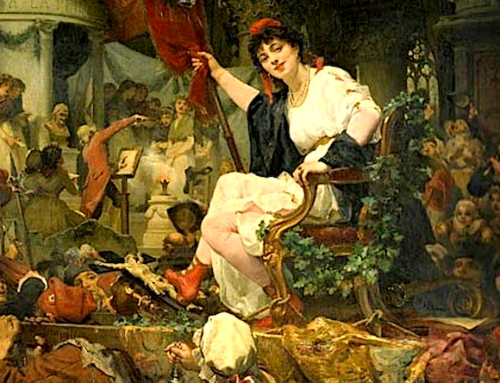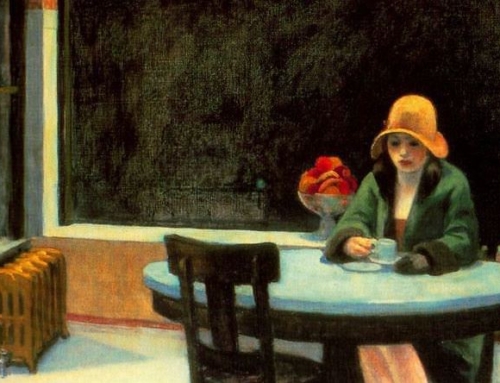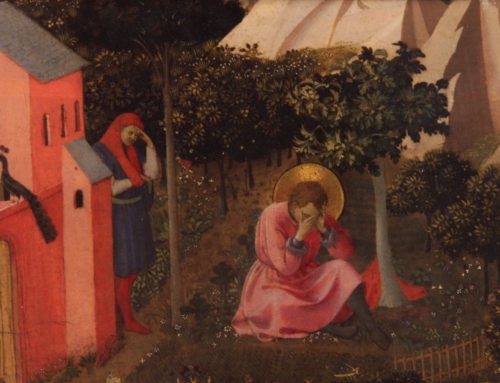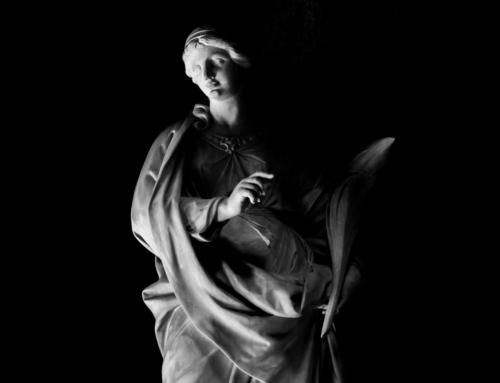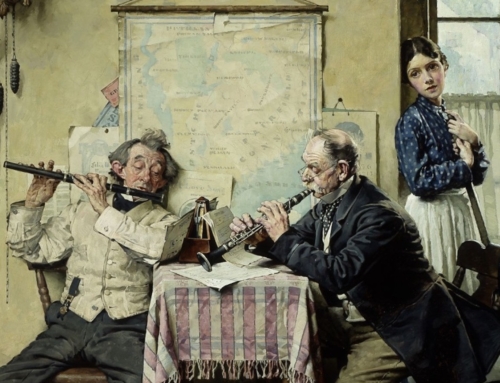Damien Hirst’s Battle Between Good and Evil (2007) consists of two beach balls, one black and one white, suspended in the air by an air blower above a surface geometrically divided into white and black spaces. Occasionally the balls bounce into each other.
The point is clear enough: this whole morality thing is a dirty little trick made to make man feel imperiled, keeping him locked in conflict hovering just above the surface of the real world. Art, able to see things more clearly, can use both good and evil as playthings to be batted around.
Inter mirifica, the oft-neglected Vatican II decree on the media of social communications whose fiftieth anniversary was yesterday, proposes a different view of the relationship between art and morality. The call for the arts and media to be moral, to allow men to rise to their full dignity, sounds throughout the document. It is the moral order that
by itself surpasses and fittingly coordinates all other spheres of human affairs—the arts not excepted—even though they be endowed with notable dignity. For man who is endowed by God with the gift of reason and summoned to pursue a lofty destiny, is alone affected by the moral order in his entire being. And likewise, if man resolutely and faithfully upholds this order, he will be brought to the attainment of complete perfection and happiness (IM 6).
But what does it really mean for art or media to be moral? Can we determine the morality of a movie just by tallying up the number of curse words, violent acts, and intimate rendezvous and weighing it against the number of sage priests, confessing penitents, and confounded evildoers? If Good Things outweigh Bad Things in the work, do we have a moral work of art?
The temptation to answer “yes” to these questions is more strongly present in contemporary America than the soft relativism of our culture might lead us to expect. Most of us acknowledge that some matters “deserve reverent handling” and others “quite readily arouse base desires” in those who see or hear them depicted (IM 7); what we differ on is the things we disapprove of. Some protest that sex in movies corrupts the youth; others protest that smoking in movies does. Some protest featuring same-sex parents on prime-time sitcoms because it undermines the family; others protest their absence, because that undermines the family. So is art always doomed to charges of immorality?
Inter mirifica proposes a subtle solution to this problem by bypassing its unspoken premise: that a work of art depicting immorality is by that fact immoral. Within the limits of prudence and reverence,
the narration, description or portrayal of moral evil, even through the media of social communication, can indeed serve to bring about a deeper knowledge and study of humanity and, with the aid of appropriately heightened dramatic effects, can reveal and glorify the grand dimensions of truth and goodness (IM 7).
At first glance, this is obvious: without the ability to depict evil seriously, art would cease to be a serious route by which man comes to understand his fallen state. But the Council Fathers are also making a deeper point about the inner dynamic of artistic creation, which is to “reveal and glorify . . . truth and goodness.” Within reasonable bounds, a work of art does not become moral or immoral based simply on what it depicts, but on what it reveals about truth and goodness, which are fundamental dynamics of reality as given to men by God. As John Paul II stated in his Letter to Artists, “Every genuine art form in its own way is a path to the inmost reality of man and of the world”; art that intentionally deviates from this path undermines its own meaning and may cause real harm. The call for moral art, then, is a call for art that reveals reality, that makes known the inner meaning of man’s life by means of the artist’s own radically personal engagement with that reality and his interpretation of it.
In this light, the artist begins to walk a troublesome road when he gives up his quest for the deepest reality he can reach and settles instead for a limited, partial, and more easily managed version of reality. Just pick up a piece of proletarian literature from the early twentieth century (Hayama Yoshiki’s “Letter Found in a Cement Barrel” comes to mind) to understand how easy it is for the ideologue to write literature, and how deeply he corrupts its meaning. Ideology, sensationalism, scandal-mongering, pandering, and sentimentalism sell big at bookstores and on the silver screen, but at a big cost: abandoning both reality and art in favor of something less.
Genuine art comes into being where truth and goodness well forth in splendor to reveal some mysterious aspect of reality; a work of art in which these diverse components (truth, goodness, and beauty) are set at odds or in conflict transgresses not only the moral order but the authentic character of art by limiting some aspect of reality in a fundamentally dishonest way. Morality in art, then, is not an external force imposing baneful restrictions on man’s free creativity, but rather it is the way in which that authentic creativity realizes itself. It is at once subjective and objective, perspectival and universal, ordered and free. In its own way, Inter mirifica shows that to set these alternatives against each other, as Hirst does by having “art” vanquish “good and evil,” is not to set man free to realize his dignity as an artist, but to reduce him to playing with beach balls.
✠
Image: Damien Hirst, Battle Between Good and Evil



